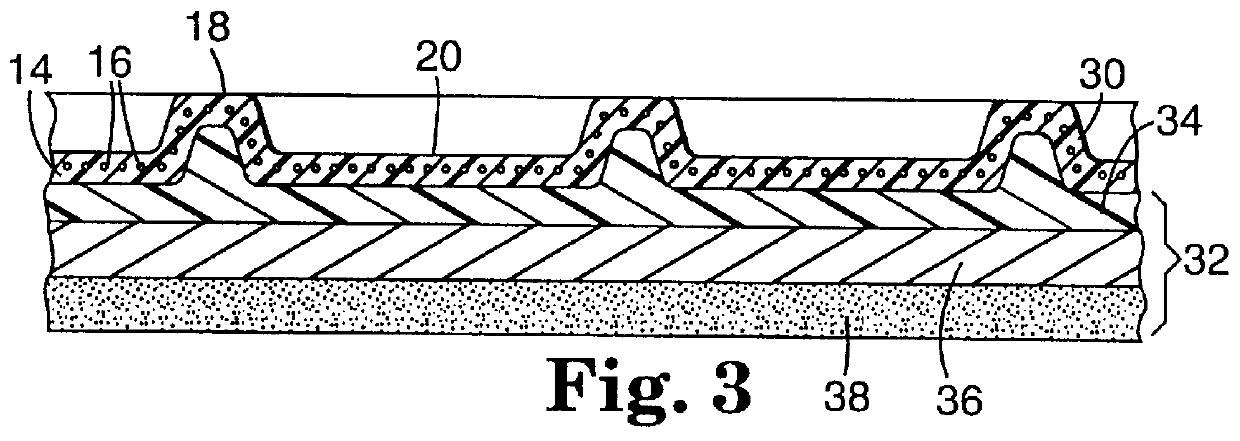Method of making wet retroreflective marking material
- Summary
- Abstract
- Description
- Claims
- Application Information
AI Technical Summary
Benefits of technology
Problems solved by technology
Method used
Image
Examples
example 1
An embedded-lens retroreflective article was made as follows. A thermoplastic, aliphatic, polyester polyurethane resin (MORTHANE Brand PN 3429-215 from Morton International Inc.) was extruded onto a 60 micron (2.4 mil) thick biaxially oriented polyethylene terephthalate ("PET") carrier web using a single screw extruder and a film die under normal extrusion coating techniques to obtain a 50 micron (2 mil) thick urethane film. This film was then hot laminated to the primed front surface of a high angularity retroreflective sheet, 3M SCOTCHLITE Brand Reflective License Plate Sheeting No. 3750 (the 3750 sheeting) comprising a layer of pressure sensitive adhesive covered by a release liner on the back side thereof, by passing between a rubber pressure roller and heated metal roller heated at 150.degree. C. (300.degree. F.) using 19 kilograms.sub.force / centimeter width at 6.1 meters / minute (20 feet / minute). The 3750 sheeting was primed by coating with Q-THANE Brand QI 4820 polyurethane s...
example 2
A retroreflective article was made using the following conditions.
A. EXTRUSION OF TOP FILM
Polyurethane resin (MORTHANE Brand L425.91 granular resin from Morton International Inc., Seabrook, N.H.) was dried in a dehumidifying drier for 18 hours at 54.degree. C. The resin was extruded through a 31.75 millimeters 24:1 single screw extruder using a screw speed of 80 RPM. The melt was fed through a flex lip film die and extrusion coated onto a 0.06 millimeters polyethylene terephthalate (PET) film using common extrusion coating techniques. The take away speed of the casting wheel was adjusted to yield a film which was edge trimmed to a 0.317 meter width and had a coating thickness of approximately 0.1 millimeters. The film was rolled up for use later.
B. PREPARATION OF RETROREFLECTIVE SHEET AND CONFORMANCE LAYER
3M SCOTCHLITE Brand Reflective License Plate sheeting No. 3750 was primed using an aliphatic polyurethane solution (QC 4820 from K. J. Quinn & Co.). The QC 4820 solution was first ...
example 3
A colored retroreflective article was made according to Example 2 with the following modifications. Yellow transparent dyes were added to the topfilm. Colored pellets were made which were later used when extruding the topfilm to make a colored topfilm.
The colored pellets were made by compounding on a 34 millimeter twin screw extruder, operating in a corotating mode at 450 RPM. Strands were extruded through a strand die and cooled in water. Excess water was blown off after the strands were removed from the water bath. The strands were pelletized in a Conair model 304 pelletizer. For this pellet, the formulation was 99.135 parts by weight of the L425.91 resin, 0.85 parts by weight of the Amaplast GHS (available from Colorchem International, Atlanta Georgia), and 0.015 parts by weight of the Amaplast Red LB (also available from Colorchem International).
The extrusion of the colored topfilm was the same as in Example 2, Section A. However because colored pellets were used, the resulting ...
PUM
| Property | Measurement | Unit |
|---|---|---|
| Length | aaaaa | aaaaa |
| Angle | aaaaa | aaaaa |
| Angle | aaaaa | aaaaa |
Abstract
Description
Claims
Application Information
 Login to View More
Login to View More - R&D
- Intellectual Property
- Life Sciences
- Materials
- Tech Scout
- Unparalleled Data Quality
- Higher Quality Content
- 60% Fewer Hallucinations
Browse by: Latest US Patents, China's latest patents, Technical Efficacy Thesaurus, Application Domain, Technology Topic, Popular Technical Reports.
© 2025 PatSnap. All rights reserved.Legal|Privacy policy|Modern Slavery Act Transparency Statement|Sitemap|About US| Contact US: help@patsnap.com



